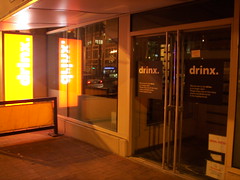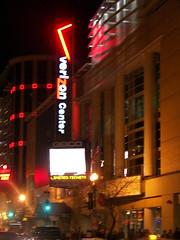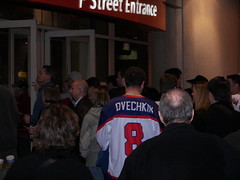Layering, location, and business failure as an indicator
 No restaurant located in this space, at 6th and F Streets NW, within the now-named Verizon Center, has ever been successful since the Arena opened in 1998.
No restaurant located in this space, at 6th and F Streets NW, within the now-named Verizon Center, has ever been successful since the Arena opened in 1998.Speaking of neighborhood blogs, had Gallery Place Living not written about it, I wouldn't have known that Red Sage restaurant is closing this Friday. Even though I did see it in GP Living, because I had happened to walk by last Friday, I did know that Drinx restaurant, located at 6th and F Streets NW within the Verizon Center, closed.
This brings up a couple points.
1. Like the incorrect nostrum that the Reeves Center* at 14th and U Streets NW brought about the improvement in that area, the other similar nostrum is the impact of the now-named Verizon Center on 7th Street NW as the augur of improvement in downtown's East End.

I do think this is an important contribution, but as if not more important:
a. a decrease in the inventory of available developable land in the center and west of the Central Business District;
b. the fact that 7th Street NW from Pennsylvania to New York Avenues has the longest extant stretch of historic buildings;
c. plus ground floor retail that respects the historic rhythm and pacing of the pedestrian;
d. and that there are many other things to do over there as well (a/k/a the layering of multiple attractions-destinations), ranging from coffee shops (3 Starbucks, 1 Juan Valdez Coffee joint), the Shakespeare Theater, one of the most successful restaurants in the city--Jaleo--as well as other hip places such as Matchbox; newly opened Smithsonian museums, a 24 hour drug store, more retail (chains yes, but it's open), etc.
But I will admit that events at the Verizon Center help bring people downtown, especially those people who might not otherwise be willing to sample it (suburbanites).
2. However, because of the way that the sports teams schedule events to start at 7 pm, means that there is little spillover benefit to nearby businesses, because people scoot from work to their seats, without an interim stop at a local restaurant or pub. And because people work early and long hours, people tend to go out to other places in the area after events only on Fridays, Saturdays, and Sundays.

3. Frankly, as I always say, and Drinx proves it, if Verizon (née MCI) Center was so great, then the retail wouldn't keep failing. But it does. Because it's high-priced and attempts to draw in people off from the street, when it is the excitement of the street that draws people to 7th Street.
 Upstairs at the Red Sage.
Upstairs at the Red Sage.4. Similarly, the Red Sage, once one of the hottest restaurants in the city, is closing, because they say that can't afford a significant increase in rents.
One of the problems the Red Sage has is it's a bifurcated concept, a fine dining restaurant in the basement, and a more casual dining place upstairs. And because the cost of the buildout was so expensive--ranging from specially cast ironwork for tables and chairs, to buffalo hides for chair and booth coverings, the restaurant needed to gross $10,000/day just to break even!
And downtown isn't as good a restaurant market as you think. The competition is fierce. Luncheon business is great (but for most places only 2 turns, because people don't come out to eat until 12:30 pm), but evening and weekend business can be really bad. Sundays too. And July and August, especially at night, are pathetic. Yet, because it's "downtown" restaurants continue to open there. They fail too. Although this will change as there are more things to do Downtown than just work.
(In fact, I think people like the owners of Cafe Deluxe are pretty smart--own a neighborhood lock, stock, and barrel, like their location in the Cathedral area--and you make tons of money with limited competition. The same goes for the folks at Lauriol Plaza on 18th Street NW in Dupont Circle.)
E.g., last Saturday as I was walking past the old Woodies building, which has signage announcing that West Elm will be opening a store there next year, people just ahead of me commented "We just went to Tyson's Corner to go to West Elm..."
And as DC1974 commented in an earlier thread, Downtown has an advantage over Tyson's and Georgetown in that it is less congested, and if you're on transit, a lot easier to get to and get around.
Still, rents matter, and the cost of buildout matters, and patronage matters. Despite the rent rates that building owners want, DC doesn't have the kind of pedestrian traffic necessary to justify very high rents, even Downtown.
* Back to the Reeves Center. If it were so great:
a. It wouldn't have taken 13-15 years after it was constructed for the neighborhood to improve;
b. The retail within the building wouldn't have gone through many iterations of failure;
c. Buildings across the street wouldn't be sitting on the market, empty, available for rent, for years and years with little activity;
d. There wouldn't be empty lots and used car lots within one block of the Reeves Center;
e. And probably there wouldn't be a McDonald's across the street either.
Index Keywords: retail; stadiums-arenas; urban-revitalization



0 Comments:
Post a Comment
<< Home